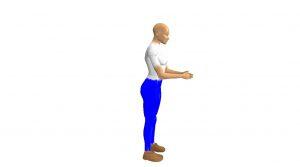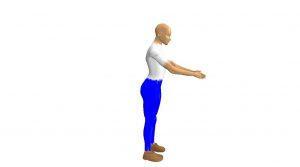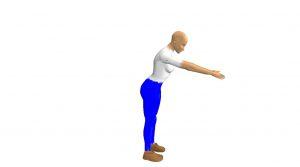If you’re familiar with ergonomics design guidelines, then you are aware of the CSA guideline (CSA Z1004-12) that provides recommended reach guidelines for “frequent”, “infrequent”, and “occasional” work. What do these guidelines represent?
 For reach, we usually are most concerned with a smaller worker, because a larger worker could stand further back, and achieve the same posture. This graphic shows the posture used by an average-height female, at the far side of the “frequent” work zone. Frequent work should be performed without reaching forward more than this. You can see that her shoulders are relaxed, and her elbows are close to the side of the body. The guidelines are essentially saying that “frequent” work should be done without reaching or bending, to keep the shoulders in a neutral position. This is also the most efficient work location, since the hands are always close to the body. In this position, a worker has optimum strength, and visibility, so work quality will also be highest.
For reach, we usually are most concerned with a smaller worker, because a larger worker could stand further back, and achieve the same posture. This graphic shows the posture used by an average-height female, at the far side of the “frequent” work zone. Frequent work should be performed without reaching forward more than this. You can see that her shoulders are relaxed, and her elbows are close to the side of the body. The guidelines are essentially saying that “frequent” work should be done without reaching or bending, to keep the shoulders in a neutral position. This is also the most efficient work location, since the hands are always close to the body. In this position, a worker has optimum strength, and visibility, so work quality will also be highest.
 This graphic shows the posture used by an average-height female, at the outer edge of the “infrequent” work zone. The guidelines are suggesting that reaching with the shoulders is okay on an “infrequent” basis, but the back should remain in a neutral upright posture most of the time. We can store supplies or tools that the worker doesn’t need all the time in this area. A worker has less strength, and probably can’t see detail as well in this reach zone, so work quality would be impaired if work was performed in this range more than “infrequently”.
This graphic shows the posture used by an average-height female, at the outer edge of the “infrequent” work zone. The guidelines are suggesting that reaching with the shoulders is okay on an “infrequent” basis, but the back should remain in a neutral upright posture most of the time. We can store supplies or tools that the worker doesn’t need all the time in this area. A worker has less strength, and probably can’t see detail as well in this reach zone, so work quality would be impaired if work was performed in this range more than “infrequently”.
 This graphic shows the posture used by an average-height female at the far side of the “occasional” work zone. Here, the guidelines are suggesting that bending and reaching are okay on an “occasional” basis. We can position items in this area only if they will be used occasionally.
This graphic shows the posture used by an average-height female at the far side of the “occasional” work zone. Here, the guidelines are suggesting that bending and reaching are okay on an “occasional” basis. We can position items in this area only if they will be used occasionally.
For more details and insights into “ergo design guidelines”, join us on October 29 in Kitchener for our one-day course.


